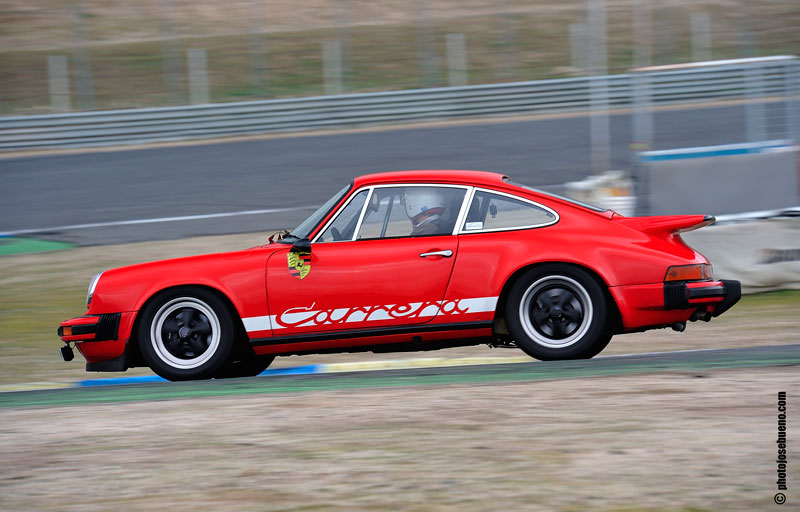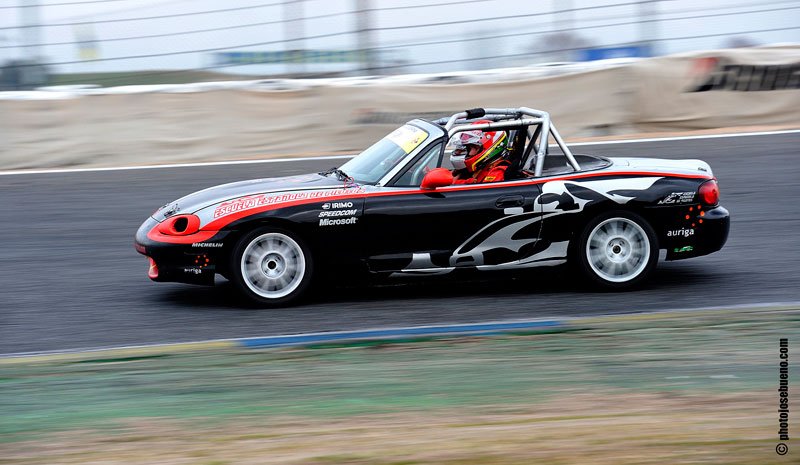
Una vez más no vamos a un circuito, El Jarama en Madrid, para pasar un día ameno con la Escuela Española de Pilotos. Antes de entrar en materia con el tema de fotografía diré que la Escuela Española de Pilotos lleva nada menos que desde 1980 dedicando sus esfuerzos a la formación de pilotos así como su contribución a la mejora de la seguridad vial. En ese tiempo han pasado mas de veinte mil alumnos, alguno de ellos con gran renombre como Carlos Sainz, Pedro M. De la Rosa, Marc Gené, Fernando Alonso, …
He de reconocer que en alguna ocasión he acudido como alumno pues me encanta el formato que tienen y es que cada ve que sales a pista un instructor te acompaña en el asiento del copiloto mejorando todo aquello que necesitas y por supuesto teniendo en cuenta tu nivel. Esto resulta muy divertido además de interesante pues la primera vez que hice un curso bajé nada menos que 5 segundos mi tiempo por vuelta.
Pero en esta ocasión vuelvo a formar parte de la Escuela haciendo la labor de fotógrafo que también me da muchas satisfacciones. Poder hacer todo tipo de tomas oliendo a pié de pista los coches, es todo un lujo.
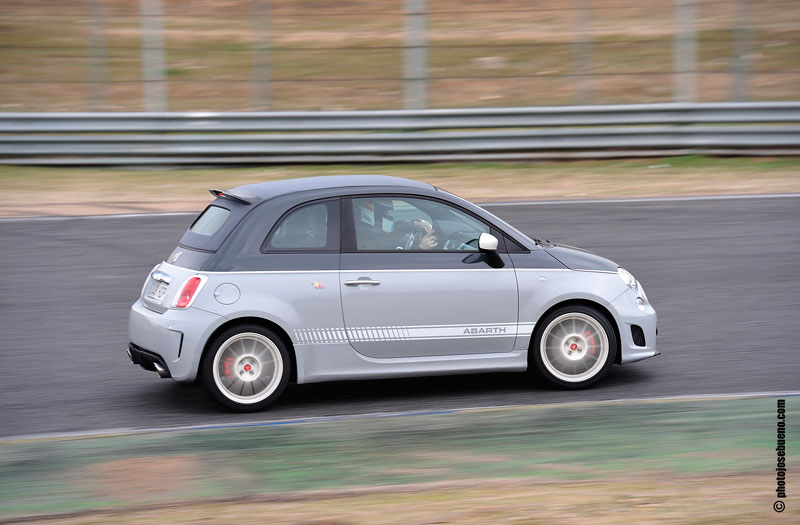
Nikon D700 Nikkor 70-200VRII – f:5.6 – 1/80s – ISO 400
Como siempre y antes de ir a un evento decido que equipo llevar y hago la consabida revisión. En este caso solo tuve que limpiar con aire el sensor ya que tenía una mota que a buen seguro hubiese estropeado más de una foto. El tiempo anunciaba chubascos intermitentes y por ello decidí llevar mi chaqueta Gitzo, genial para trabajar con mal tiempo. Como es un circuito que conozco tan solo llevé el cuerpo Nikon D700 y los Nikkor 24-70mm. y 70-200mm.VRII, ambos con f:2.8. También llevé el monopié Manfrotto y el polarizador de la marca B+W, de lo mejor.
Una vez allí pude hacer las primeras tomas siempre interesantes de los mecánicos realizado ajustes, los pilotos concentrados antes de salir etc. Lo que más me gusta es el buen ambiente y la buena disposición del Director de la Escuela, Javier Morcillo, siempre dispuesto a resolver dudas a los participantes.
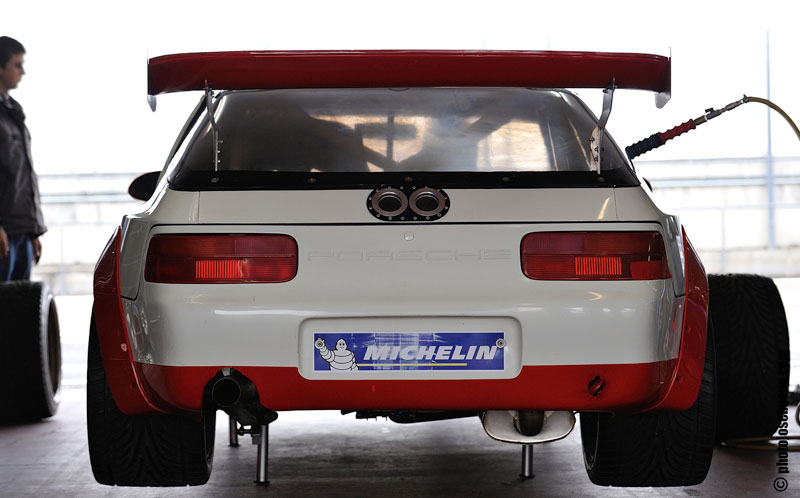
Nikon D700 – Nikkor 24-70mm. – f:4.5 – 1/80s – ISO 1250
Entre tanda y tanda aproveche para ir con mi pequeño coche hasta una de las zonas más interesantes aprovechando que por la mañana el sol está a favor y además se pueden hacer interesantes planos de barrido, estáticas y apoyos, vamos casi toda la gama de fotos deportivas en pista.
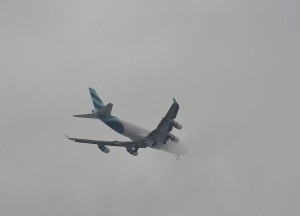 Como el día estaba muy nublado, el polarizador me resultó de gran ayuda e incluso pude hacer alguna toma a contraluz y es que el ambiente nublado a veces ayuda si bien no es la luz que más me gusta para trabajar en un circuito.
Como el día estaba muy nublado, el polarizador me resultó de gran ayuda e incluso pude hacer alguna toma a contraluz y es que el ambiente nublado a veces ayuda si bien no es la luz que más me gusta para trabajar en un circuito.
Los barridos que realicé los hice controlando la velocidad y es que en este tipo de eventos te encuentras coches de carreras que van pilotados por gente experta y pasan muy rápidos y también te encuentras otros participantes con menos experiencia que al pasar más lentos, necesitas bajar la velocidad para hacer un buen barrido. Personalmente prefiero hacer el barrido con la cámara en la mano sin el monopié ya que me da mucha más libertad de encuadres. Es cierto que juego con la ventaja del VR del Nikkor 70-200mmVRII que es fantástico a la hora de eliminar vibraciones. En ocasiones también utilizo el monopié y es cierto que lo usé en algún momento de la mañana pero no hay que olvidar quitar el VR del objetivo.
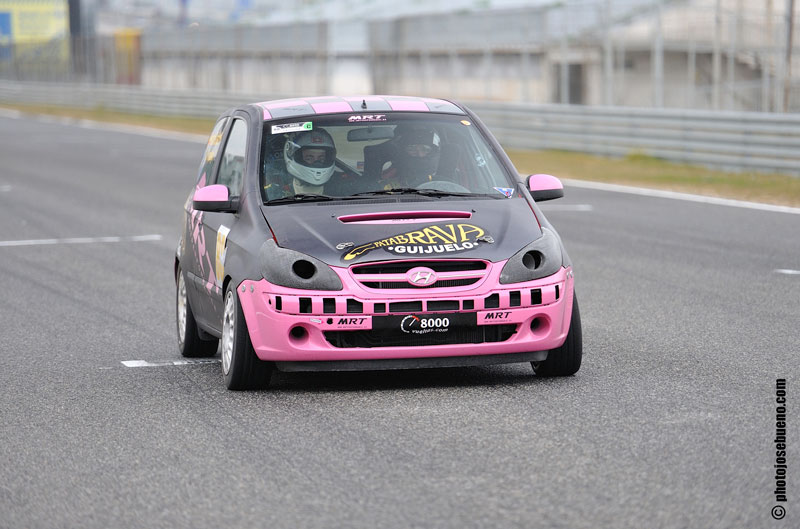
Nikon D700 – Nikkor 70-200mm.VRII – f:2.8 – 1/1600s – ISO 1600
En la zona de la recta situado en el muro, también hice fotos a los coches que se dirigían a gran velocidad hacia mi cámara. En este caso lo interesante el destacar el coche y su piloto pues por lo general a todo el mundo le gusta salir en una situación así. Además resulta interesante ambientar la imagen dejando constancia que el coche circula por un circuito. En estas tomas me gusta poner el diafragma con una apertura grande para conseguir desenfocar el fondo e insinuar la situación de velocidad en un circuito.
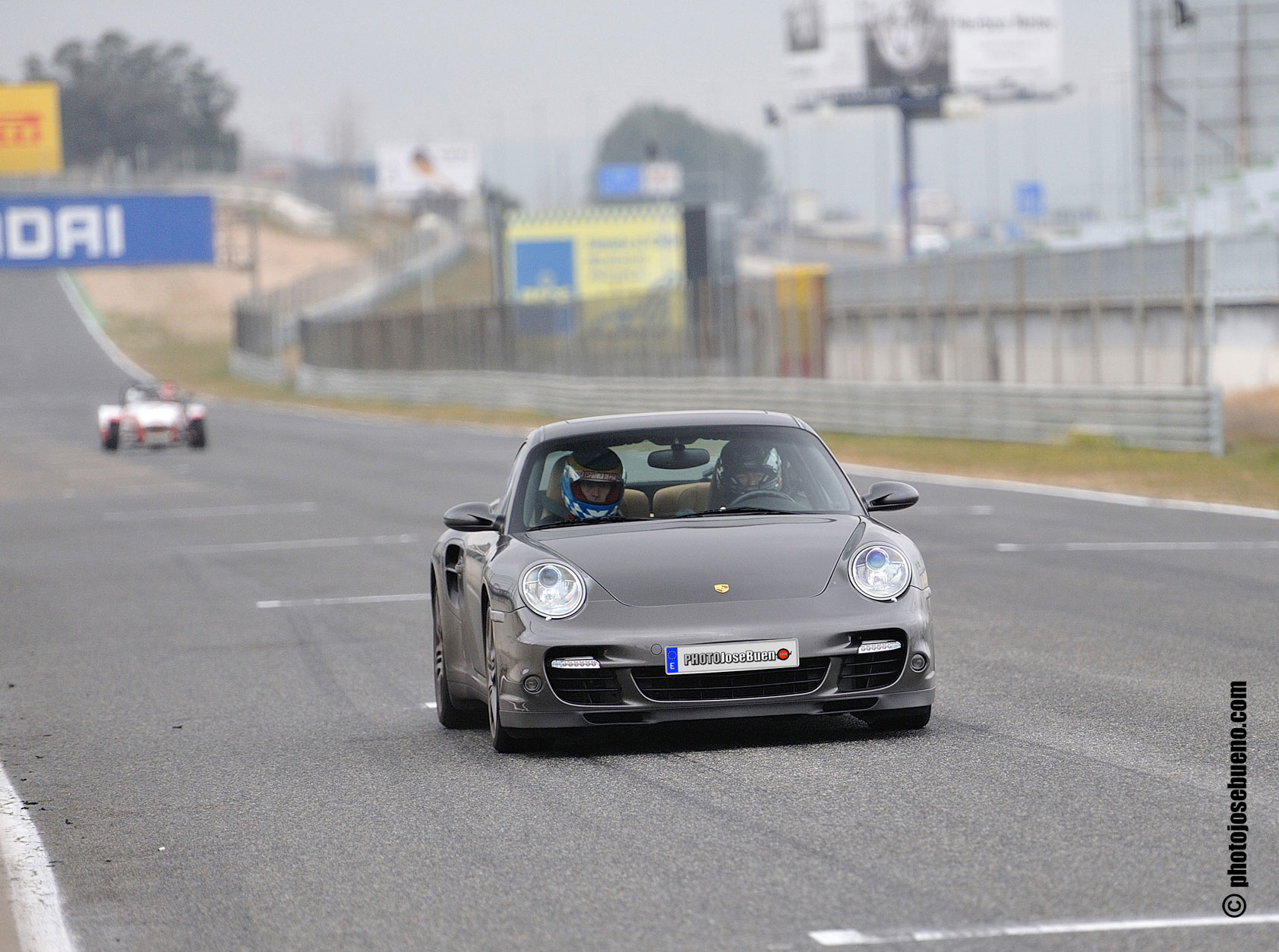
Nikon D700 – Nikkor 70-200mm.VRII – f:2.8 – 1/1600s – ISO 1600
En este tipo de fotografía es muy importante hacer un buen enfoque y eso no es precisamente fácil con cámaras “lentas”. Afortunadamente la Nikon D700 es bastante ágil a la hora de trabajar con el sistema AF de servo continuo que utiliza el sistema de seguimiento con enfoque predictivo. Este sistema es cierto que a veces me sacaba fotos desenfocadas pero volviendo a confiar en la electrónica, últimamente llevo programado la prioridad al enfoque en lugar del disparo lo que me permite hacer ráfagas a veces con menos imágenes pero todas enfocadas. Cuando probé la Nikon D4 esto fue lo que más me gustó y sorprendió … su velocidad de enfoque … increíble, lástima su precio pero todo se andará.
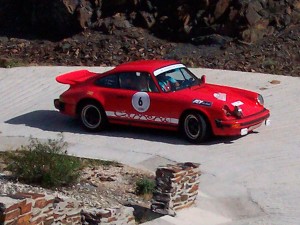
También tengo una curiosa anécdota que me sucedió y que quiero compartir con vosotros. Tengo por costumbre que entre coche y coche, si me da tiempo, suelo comprobar la nitidez de las imágenes y para ello suelo ampliar a una zona con “dibujos” como la matrícula o una pegatina. Pues bien haciendo esto, de repente uno de los coches que estaban rodando y que se parecía mucho a uno que tuve hace años, al ampliar la matrícula comprobé que se trataba de la misma unidad de la que fui propietario y que dio nombre a mi nick en algunos foros por su color más el modelo: “Furiaroja911”. Con ese coche participé en varios rallyes. Curiosamente en el Rallye de Torrelodones, allá por el año 2004, otro colega me sacó una foto en la que estaba a punto de perder el faro derecho como se puede apreciar en la foto. Transitábamos por uno de los duros tramos del rallye conocido como la «Muralla China», un tramo ideal pare perder el faro y los empastes. La conclusión es que pequeño que es el mundo. Fue todo un placer realizar fotos a un coche que no veía desde hace años y que me llenó de satisfacción al comprobar su buen estado físico dándolo todo en un circuito.
También coincidí con un buen amigo, Antonio Castro, piloto ganador entre otros del Campeonato de España GT y que acababa de recibir un coche preparado para circuito que había comprado hace poco en Inglaterra. Estaba allí para probar por primera vez ese coche y dejarlo preparado para pruebas de este año y vaya que lo probó. En el ejemplo vemos una apurada de frenada donde el coche se quedó totalmente clavado. Este tipo de situaciones se suelen dar en carrera y si estas atento puedes tomar unas increíbles fotos. Por suerte también mi amigo Antonio hizo esta increíble apurada justo delante de donde estaba preparado con mi cámara. Estaremos atentos a la evolución de este coche pues seguro que en las manos de su actual propietario ganará más de alguna prueba.
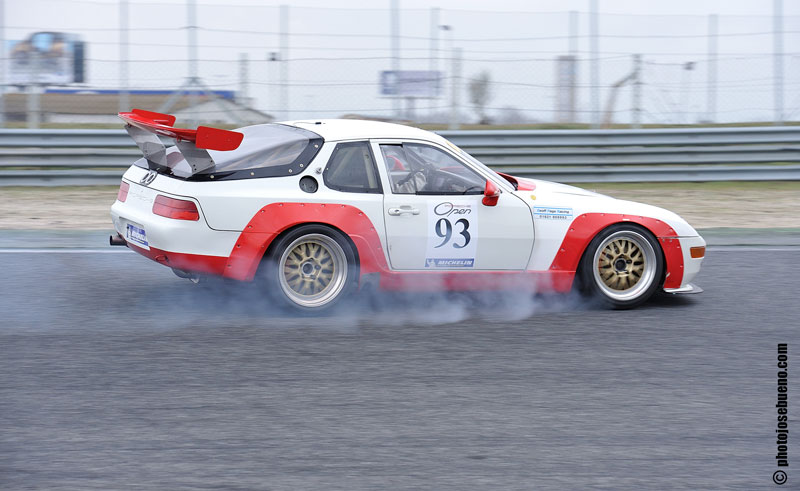
Nikon D700 – Nikkor 70-200mm.VRII – f:6.3 – 1/200s – ISO 800
Para terminar, si te interesa el mundo del automóvil y quieres hacer tus pinitos en un circuito te aconsejo que contactes con la Escuela Española de Pilotos pues nadie mejor que ellos te podrás asesorar en el mundo de la competición y si tan solo quieres aprender a llevar tu coche en el límite … pues también es la mejor y más segura manera de hacerlo. Por cierto que también tienen coches de competición en alquiler. En definitiva son profesionales en todos los sentidos.
A day in the Spanish Pilot School
Again, do not go to a circuit, the Jarama in Madrid, for a day fun with the Spanish School of Pilots. Before entering the field of photography to tell the subject that the Spanish School of Pilots take no less than from 1980 to devote his efforts to the training of pilots and their contribution to improving road safety. In that time they have spent more than twenty thousand students, some of them with great popularity as Carlos Sainz, Peter M. De la Rosa, Marc Gené, Fernando Alonso, …
I must admit that on occasion I attended as a student because I love having format is that each sees you go to track an instructor with you in the passenger seat improving everything you need and of course taking into account your level. This is very interesting as well as fun the first time I did a course got no less than 5 seconds my lap time.
But this time I return to join the school doing the work of photographer that also gives me great satisfaction. To make all kinds of shots to door smelling cars, is a luxury.
How long before going to an event and decide what equipment I carry the usual review. In this case only had to clean the sensor air as it had a speck that surely would have ruined more than one photo. Weather announcing intermittent showers and so I decided to take my jacket Gitzo, great to work in bad weather. As it is a track I know I took the body only Nikon D700 and Nikkor 24-70mm. and 70-200mm.VRII, both with f: 2.8. I also took the Manfrotto monopod and polarizer B + W brand, the best.
Once there I could do the first shots always interesting mechanics made adjustments, pilots etc concentrates before leaving. What I like is the atmosphere and the willingness of the School Director, Javier Morcillo, always willing to answer questions to the participants.
Among tanda tanda and take a ride with my little car to one of the most interesting areas taking advantage of the morning sun and also favors can be made interesting scanning planes, static and supports, we almost the whole range of sports photos on track.
As the day was overcast, the polarizer me was very helpful and even I could do some back-and that the environment is cloudy sometimes helps but is not the light that I like to work in a circuit.
I made scans I made controlling the speed and is that in this type of events you are going racing cars driven by people skilled and very quick pass and you find other participants with less experience than passing slower, lower need speed to make a good sweep. Personally I prefer to sweep the camera in hand without the monopod as it gives me much more freedom of frames. It is true that game with the advantage of VR Nikkor 70-200mmVRII it’s great when eliminate vibrations. Sometimes I also use the monopod and it is true that I used it at some time in the morning but do not forget to remove the lens VR.
In the area of the line located on the wall, also took pictures of the cars that were heading at high speed toward my camera. In this case the interesting thing highlighting the car and its driver because usually everyone likes to go out in such a situation. Also interesting image acclimate noting that the car is traveling a circuit. In these shots I like to put the diaphragm with a large aperture to blur the background and get the situation suggest a circuit speed.
In this type of photography is very important to make a good approach and that is not exactly easy with cameras «slow». Fortunately the Nikon D700 is quite agile when working with continuous-servo AF system that uses the system with predictive focus tracking. This system is true that sometimes I took pictures blurry but returning to rely on electronics, lately I’ve programmed the priority approach shot instead of allowing me to do sometimes bursts with fewer images but all focused. When I tested the Nikon D4 that was what I liked and was surprised … Focus speed … amazing, shame its price but everything will come.
Also I have a funny story that happened to me and I want to share with you. Well, I have the habit that between car and car floor if I have time to check the sharpness of images and ground it extend to an area with «drawings» as tuition or a sticker. Well doing this, suddenly one of the cars that were rolling and that was a lot like one I had years ago, to expand enrollment saw that it was the that was mine and gave my name to Nick in some forums for their color «Furiaroja911» and with that car is that I made several rallies. The strange thing is that in Torrelodones Rally back in 2004, another colleague I took a picture in which he was about to lose a lighthouse as seen in the photo on one of the hard sections of the rally known as the Chinese Wall. How small the world is. It was a pleasure taking photos at a car that had not seen for years and I could see her taking it all fit in a circuit.
It also coincided with a good friend, Antonio Castro, winning driver including GT Championship of Spain and he had just received a car prepared for the circuit had recently purchased in England. I was there to try for the first time that car and make it ready for testing this year and boy was it tested. In the example we see a rush of braking where the car was totally stuck. Such situations often occur in the race and if you sense you can take some incredible photos. Luckily my friend Antonio also made this incredible rush right in front of where I was ready with my camera.
Finally, if you are interested in the automotive world and want to make your first steps on a circuit I advise you to contact the Spanish School of Pilots for no better than they can advise you in the world of racing and if you just want to learn to lead your car to the limit … it also is the best and safest way to do it. Of course they also have racing cars for rent. Ultimately are professional in every way
